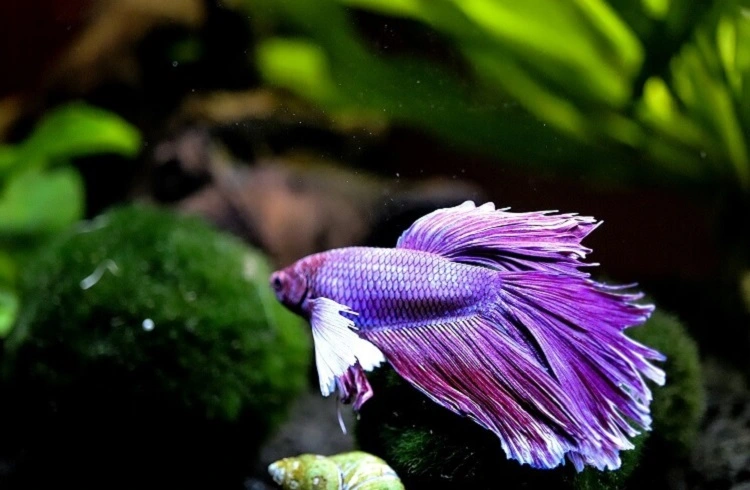We understand your passion for providing your Betta fish with the best care! However, sometimes it can be a bit difficult to understand what your fish is going through. Betta fish are known for their stunning appearance and sensitivity to various diseases. Today we will discuss the Betta Fin Rot, one of the most common Betta fish diseases.
In this article, we will be discussing Betta fin rot in detail. You will discover how Betta fish can get fin rot and what are its symptoms. In addition, we will equip you with the knowledge to effectively cure it. We will also cover preventative measures to help you keep your Betta fish healthy in the first place. Here is a quick Intro to Betta Fin rot.
| Name: | Fin Rot, Tail Rot, Fin Melt |
| Scientific Name | Pseudomonas fluorescens, Aeromonas and Vibrio |
| Causes | Stress, poor water quality, and a dirty tank |
| Symptoms | Deteriorated fins, lethargy, and loss of appetite |
| Cure | Maintain a clean tank and use antibiotics |
| Contagious | Not highly contagious |
Ever wondered what Betta fin rot looks like? Before we answer that, let’s understand what Betta fin rot is. Here’s a detailed explanation.
What Is Fin Rot?
Fin rot is one of the most common diseases in Betta fish. Especially, Betta fish in captivity like a tank setup are more prone to Betta fin rot. Generally, this disease is caused because of the bacteria in the tank. Due to this infection, Betta’s fins will become ragged, frayed, and discolored. Moreover, your Betta can feel lethargic and lose its appetite.

The main causes of Betta fin rot include stress and an unclean tank environment. Fin rot targets the fish’s immune system. As the immune system is compromised, the body becomes defenseless. Thus, many diseases, including fin rot, can strike. Other symptoms include overcrowded tanks and aggressive tankmates.
Primarily, this disease affects the tail fin. This leads to major health issues for the fish. Fortunately, with proper treatment, your Betta can get rid of this disease. For a more detailed discussion of the symptoms and cure, continue reading the article.
Causes of Betta Fin Rot
Primarily, Betta fin rot is an infection caused by bacteria. Mostly, it is caused by the bacteria Pseudomonas fluorescens. However, Aeromonas and Vibrio bacteria can also cause fin rot. But the question is: How do these bacteria end up in the tank?
Poor water quality with high levels of ammonia, nitrite, and nitrates is the main cause of Betta fin rot. These unmaintained parameters provide the ideal environment for these bacteria to thrive. This leads to an outbreak in the tank, ultimately compromising the fish’s health. So now you know, Betta fish that live in poorly maintained tanks are at high risk of developing fin rot.

Additionally, overcrowded tanks can create a high ammonia and nitrate environment. The more fish there are, the more waste they produce!
Other factors that lead to fin rot include stress, aggressive tank mates, and overcrowded tanks. Tank mates who are not compatible with your Betta fish can bully them and cause stress.
All these factors contribute to a Betta fin rot outbreak in the tank. If not treated promptly, it can affect other fish as well. So, it’s best to avoid all these factors to keep the disease out of the tank in the first place.
Betta Fin Rot Symptoms
Understanding Betta fin rot symptoms is very important. After all, you can only cure a disease if you know how it looks. This particular disease has three stages. Recognizing the symptoms in the early stages can be beneficial. Here are some of the symptoms of Betta fin rot along with relevant stages.
Symptoms in the Mild Stage:
This is the initial stage of fin rot. If you detect the disease in this stage, you’re in luck. The Mild stage fin rot is the easiest to cure. Here are its symptoms:
- The Betta’s fins will slightly darken from the edges.
- The tips of the Betta fins will turn brown, grey, or white.
- The fin edges will look worn out, tattered, or sore.
Luckily, your fish will not feel much pain, although slight discomfort is normal. This level of fin rot doesn’t appear close to the body.

Symptoms in the Moderate Stage:
In the moderate stage, fin rot is clearly visible. This stage is quite dangerous and if you don’t treat the fish right away, the disease will advance rapidly. Here are its symptoms:
- The fin edges will become blackish or reddish as they get damaged.
- There will be noticeable tissue loss along the edges of the fins.
- A fuzzy-looking growth will be visible along the deteriorated edges.
Symptoms in the Severe Stage:
In this stage, immediate treatment is necessary. The fins and the Betta’s immune system are compromised. The fish may not recover if intensive treatment is not provided. In addition, other diseases can attack the defenseless fish, so it is at higher risk. Here are the symptoms of severe fin rot:
- Extreme fin deterioration is visible. The fins are receding close to the body.
- Loss of fin. The bloody base of the fin is visible.
- A whitish film can be seen reaching the body.
Treatment for Betta Fin Rot
Now that you know how to identify the symptoms and causes of the Betta Fin Rot, let’s move on to treating the affected fish. As we have discussed in the symptoms, this disease has 3 levels. To treat the Betta Fin Rot, you must identify the stage and act accordingly. Here are the simple and effective methods to cure the Betta Fin Rot.
Mild Stage Fin Rot Treatment:
This stage is generally easier to handle as the fish will recover quickly. Here is a step-by-step guide for treating the Betta Fin Rot in the mild stage:
- Improve the water quality. Change the water daily, about 20 to 25% water change will do. Use a Water Test Kit to check and maintain the water quality.
- Add some aquarium salt to strengthen the Betta’s immune system.
- Maintain the water temperature between 78 to 80 degrees Fahrenheit. This will reduce stress for the Betta fish.
- If tankmates aren’t bothering the affected Betta, you can treat it in the same tank. Otherwise, isolate it in a separate tank.

Moderate Stage Fin Rot Treatment:
The moderate stage is when the Fin Rot has advanced to such a level that treatment is required right away. If not treated promptly, the disease can cause intense damage and affect tankmates. Here’s what you need to do:
- Isolate the fish in a separate tank. It’s best to check the tankmates as the disease can spread in this stage.
- Increase the tank water change frequency. If ammonia or nitrite levels rise above 0 ppm, perform a water change immediately. Keep the tank parameters such as temperature and oxygen levels pristine.
- Use antibacterial medication to allow controlled treatment. Medication like Maracyn can be helpful. However, it’s best to consult a veterinarian for medication before using anything.
- Add some aquarium salt to strengthen the Betta’s immune system.
- Monitor the fish and promptly take action if you see any stress or behavior change in the Betta fish.
Severe Stage Fin Rot Treatment:
In severe cases, the Fin Rot can advance to the body. The fins are severely damaged so much so that the fish can even lose its fins. This leads to open sores and a defenseless body. Thus, it’s best to take intensive care. Here’s a guide for treating a fish with severe Fin Rot:
- Isolate your Betta fish to a separate fish tank. This can be a small hospital tank for your Betta until it’s healthy again.
- Maintain the water condition pristine by changing the water twice a day. You must change to 50% tank water. Change the water as soon as the ammonia level gets above 0 ppm. It’s best to monitor the water conditions using a Water Test Kit.
- Add some aquarium salt to strengthen the Betta’s immune system.
- Use strong antibiotics and antibacterial medications. Consult a veterinarian for proper medication and treatment. A Betta fish in this stage may take a longer time to recover, so you must have patience.
Pssst! Here are some of the best water test kits and strips to Monitor and maintain your tank water parameters.
Preventing Betta Fin Rot
To prevent Betta Fin Rot, you need to eliminate its main cause. The best thing to do is to maintain a pristine and clean tank. Your fish tank must have clear water with safe ammonia, nitrate, and nitrite levels.
You should regularly change the tank water to maintain the water quality. Changing 25 to 50 percent tank water every week is standard to keep a healthy Betta fish in a 5-gallon tank. If you have a smaller fish tank, change the water every 4 to 5 days. Additionally, you should use a Water Test Kit to monitor the water parameters.

Avoid Overfeeding! As you add extra food to the water, it gets contaminated. If the fish leaves uneaten food, the water gets contaminated. Moreover, if the fish overeats, it will produce more waste. So, under no condition does overeating benefit us.
Additionally, make sure your tank has no stressful factors, like a lack of hiding spots and aggressive tankmates. You should always have the right tank size. Small tanks might allow your fish to survive, but they will not thrive. As discussed earlier, these factors can add up to cause a Betta Fin Rot outbreak.
Lastly, take better care of your Betta fish. You see, Betta fish are as sensitive as they are beautiful. This fish can easily catch a disease if not cared for. So, it’s best to take care of your Betta and avoid a disease, rather than treating it!
How to Determine If Betta Fin Rot Is Cured
To determine if your Betta fish has recovered from Fin Rot, you need to closely observe its fins. Look for regrowth or repairing fins. Healthy fins will have no discoloration and a smooth, intact look. Keep monitoring the fish regularly as recovery might take up to several weeks. But here’s the fun part, your Betta fish might get a new look with new colors once it starts recovering; however, this may or may not occur.

FAQ’s
How quickly does fin rot develop in betta fish?
Fin rot can develop in hours or even days. It all depends on the condition of the tank and the severity of the case. It’s best to keep the tank and water condition as clean as possible. This way if the bacteria is introduced to your tank, it will not survive.
When should I see a veterinarian for fin rot?
If you have performed all the initial treatments mentioned in this article and the fish has made no recovery, it’s best to see a doc!
Usually, the fish will recover if the fin rot is mild. However, if the fin rot has advanced to moderate or severe stage, you should visit the veterinarian.
How to prevent fin rot in bettas?
The best way to prevent fin rot is to keep It out of the tank. That is only possible if you keep the tank clean and the water conditions pristine. It’s best to make a routine and maintain a hygienic aquarium with regular water changes and safe ammonia and nitrite levels.
What is the best treatment for fin rot?
The treatments mentioned in this article are good enough to treat a Betta fish with fin rot. However, if you want to take an extra step, you can use erythromycin. This medication is well-known for treating fish with fin rot.
Can salt cure fin rot?
Yes! Aquarium salt can effectively cure a fish with mild fin rot. Just keep the water clean and add some aquarium salt in the tank to get rid of the fin rot bacteria. However, if the fin rot is in advanced stages like the moderate or severe stage, aquarium salt alone is not enough. You should use a more intense medication for the fish, combined with aquarium salt.
Conclusion
So this was all about the Betta Fish Fin Rot. Today we discussed what this disease is and what are its causes. In addition, we covered its common symptoms and its stages. Lastly, we discussed how to cure your affected betta fish and how to prevent this disease.
All in all, the Betta Fish Fin Rot is a disease caused by an unmaintained tank. If the water quality isn’t up to the standard or the ammonia levels are high, the fish will get fin rot. Additionally, if the tank includes stressful factors, your Betta might get fin rot. These factors include improper tank size, stress, and an overcrowded tank.
Moreover, we also discussed how to cure the Betta Fish Fin Rot, in case your fish gets it. Take a look at the treatment mentioned above.
Let us know: Did your fish ever get fin rot? Share your thoughts and queries with us in the comments below!
Lastly, to tackle these issues, you must maintain a proper and clean tank. You should use a water test Kit to maintain all parameters and regularly change the water. Additionally, ensure there are no stress factors in the tank. Check our article on Betta fish Ick to find out more about potential Betta fish diseases.

